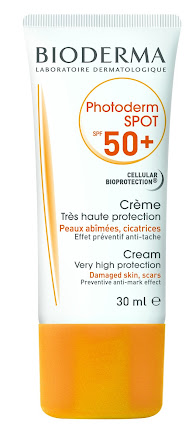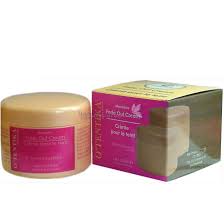REVIEW OF LA ROCHE-POSAY ANTHELIOS ANTI SHINE SPF 50+ (UVA and UVB)
Description:
Mattifying,
fragrance-free, non-tinted, facial sunscreen with broad-spectrum sun protection
factor 50+ suitable for oily, blemish-prone skin.
Product manufacturer:
This product is
manufactured under the skincare line, LA ROCHE-POSAY, a French company owned by
L'Oréal. As of 2020, L'Oréal is known as the world's largest cosmetics company
and this must be true. Name the most popular skincare lines in the world, they
are almost certainly partially or wholly owned by L’Oreal.
The company is
named after a town in the Nouvelle-Aquitaine region in western France. The French town is known for its Thermal Spring Water called La Roche-Posay. This
spring was believed to have powerful skincare properties that cured almost all
skin conditions.
In 1975, A
French pharmacist, Mr Rene Levayer created the brand “La Roche-Posay
Laboratoire Dermatologique”. There is a detailed history of the origin of this
name on the company’s website.
L'Oréal's influence in the skincare industry is undeniable, with some of the most popular skincare lines worldwide falling under its umbrella. Here are a few noteworthy brands that are either partially or wholly owned by L'Oréal:
La Roche-Posay: Renowned for its dermatologist-recommended skincare solutions, La Roche-Posay harnesses the power of the Thermal Spring Water from the town of La Roche-Posay in France to create gentle yet effective products for various skin concerns.
Vichy: Another French skincare brand, Vichy is known for its mineral-rich thermal water sourced from the volcanic region of Auvergne. The brand offers a wide range of skincare products tailored to different skin types and concerns.
CeraVe: Loved by dermatologists and skincare enthusiasts alike, CeraVe focuses on providing essential skincare ingredients such as ceramides and hyaluronic acid to help restore and maintain the skin's natural barrier.
Garnier: With a broad range of skincare products catering to different needs and budgets, Garnier has established itself as a household name in the beauty industry.
Biotherm: Originating from the French Pyrenees mountains, Biotherm utilizes thermal plankton extract in its skincare formulations to deliver hydration and nourishment to the skin.
These brands, among others in L'Oréal's portfolio, have solidified the company's position as the world's largest cosmetics conglomerate, offering consumers a diverse array of skincare solutions backed by scientific research and innovation.
Intended use:
According to
the company’s website, the product is specifically formulated for the face and
is suitable for oily skin that is prone to sensitivity, sun-intolerance, or
prickly-heat. It helps prevent acne breakouts post-sun-exposure.
Ingredients, safety in toxicity:
INGREDIENT
LIST: Aqua, Water, Homosalate, Silica, Octocrylene, Ethylhexyl Salicylate,
Butyl Methoxydibenzoylmethane, Ethylhexyl Triazone, Bis-ethylhexyloxyphenol
Methoxyphenyl Triazine, Drometrizole Trisiloxane, Aluminum Starch Octenylsuccinate,
Glycerin, Pentylene Glycol, Styrene/acrylates Copolymer, Potassium Cetyl
Phosphate, Dimethicone, Perlite, Propylene Glycol, Acrylates/c10-30 Alkyl
Acrylate Crosspolymer, Aluminum Hydroxide, P-Anisic Acid, Caprylyl Glycol,
Disodium Edta, Inulin Lauryl Carbamate, Isopropyl Lauroyl Sarcosinate, Peg-8
Laurate, Scutellaria
Description of Ingredients:
- Aqua (Water): The base solvent of the product, providing a medium for other ingredients to dissolve and mix.
- Homosalate: A chemical sunscreen agent commonly used to absorb UVB rays and protect the skin from sun damage.
- Silica: Functions as an absorbent and mattifying agent, helping to reduce shine and improve the texture of the product.
- Octocrylene: Another chemical sunscreen agent that helps to absorb UVB and short UVA rays, providing broad-spectrum protection.
- Ethylhexyl Salicylate: Also known as octyl salicylate, it absorbs UVB rays and is commonly used in sunscreen formulations.
- Butyl Methoxydibenzoylmethane: Also known as avobenzone, it absorbs UVA rays and provides broad-spectrum protection against sun damage.
- Ethylhexyl Triazone: A chemical sunscreen agent that primarily absorbs UVB rays and helps to stabilize other UV filters in the formulation.
- Bis-ethylhexyloxyphenol Methoxyphenyl Triazine: A broad-spectrum chemical sunscreen agent that absorbs both UVA and UVB rays.
- Drometrizole Trisiloxane: A photostabilizer that helps to maintain the effectiveness of other sunscreen agents in the presence of sunlight.
- Aluminum Starch Octenylsuccinate: Functions as an absorbent and anti-caking agent, helping to improve the texture and performance of the product.
- Glycerin: A humectant that attracts moisture to the skin, helping to hydrate and soften it.
- Pentylene Glycol: Functions as a solvent and humectant, helping to improve the spreadability and texture of the product.
- Styrene/acrylates Copolymer: Provides film-forming properties and helps to improve the water resistance of the product.
- Potassium Cetyl Phosphate: Functions as an emulsifier and surfactant, helping to stabilize the formulation and improve its spreadability.
- Dimethicone: A silicone-based ingredient that provides a smooth and silky texture to the product, while also helping to moisturize and protect the skin.
- Perlite: Acts as an absorbent and mattifying agent, helping to reduce shine and oiliness on the skin.
- Propylene Glycol: Functions as a humectant and solvent, helping to improve the texture and spreadability of the product.
- Acrylates/c10-30 Alkyl Acrylate Crosspolymer: A thickening agent that helps to stabilize the formulation and improve its texture.
- Aluminum Hydroxide: Acts as an opacifying agent and helps to improve the texture of the product.
- P-Anisic Acid: Functions as a preservative and has antimicrobial properties, helping to prevent the growth of bacteria and fungi in the product.
- Caprylyl Glycol: Acts as a humectant and preservative, helping to hydrate the skin and extend the shelf life of the product.
- Disodium Edta: A chelating agent that helps to stabilize the formulation and improve its shelf life.
- Inulin Lauryl Carbamate: Functions as a surfactant and emulsifier, helping to stabilize the formulation and improve its spreadability.
- Isopropyl Lauroyl Sarcosinate: A conditioning agent that helps to improve the texture and feel of the product on the skin.
- Peg-8 Laurate: Functions as a surfactant and emulsifier, helping to stabilize the formulation and improve its spreadability.
- Scutellaria: Likely refers to an extract from the Scutellaria plant, which may have antioxidant or skin-soothing properties.
Toxicity
Product search
on the European Commission’s Safety Gate: Rapid Alert System for dangerous
non-food products, did not generate any alert on this product.
How does the product work?
The active
ingredients in this product were listed as Mexoplex, combined with La
Roche-Posay Thermal Spring Water. Mexoplex (a combination of Mexoryl SX,
Tinosorb and Eldew) is an organic UVA-rays filtering compound patented by
L’Oreal. Mexoplex is said to have exceptionally high, broad photostable UVA/UVB
and Infrared protection.
An in vivo
study conducted in 2002 showed that sunscreen containing up to 5% Mexoryl can
prevent early photoaging and significantly reduce damage caused by UV exposure
in humans.
Is the product easy to use?
Yes; similar to
any other sunscreen, this product should be applied at least 30 minutes before
sun exposure and reapplied frequently and every two hours as well as after
swimming, perspiring or towelling. This should be straight forward.
Is it of high quality?
This is an
interesting one. The brand falls into the category of affordable skincare
products that would not require you to break a bank. L’Oreal as a skincare
giant has access to most of the best skincare ingredients in the world. An
example is the Mexoplex filtering system which is exclusive to L'Oréal and its
brands. Taking these points into consideration, the Anthelios Anti-Shine SPF
50+ could be classed as high quality.
Is it geared towards dark
acne-prone skin?
It sounds like this sunscreen product has definitely hit the mark in meeting some crucial expectations, especially for those with acne-prone skin. The fact that it blends seamlessly with darker skin tones, is water-based and lightweight, without leaving behind that dreaded white cast, is a huge win. These qualities not only make it comfortable to wear but also ensure that it plays well with makeup, which is a major plus.
In terms of its effectiveness on acne, while it didn't exacerbate any existing issues (a relief in itself!), it didn't completely prevent occasional breakouts either. While this might be disappointing, it's important to keep in mind that skincare can be quite individual, and what works wonders for one person may not have the same effect for another. Nonetheless, the fact that it didn't worsen acne is a definite positive, and coupled with its other benefits, it still stands as a promising option for those seeking sun protection without compromising on comfort or appearance.
Is the product worth my money?
At £17.50 for a 50ml bottle, this sunscreen falls into a moderate price range, especially when considering its targeted audience with sensitive facial skin. For those like me with finicky skin, this price could be deemed reasonable, particularly when compared to other options on the market. However, if your skin is low-maintenance and not particularly sensitive, you might find this price to be a bit steep, especially when you can snag a similar quantity of sunscreen for less than £5.
In essence, the value of this product hinges on individual preferences and needs. If you're limited in your choices due to sensitive skin concerns, then the price could be justified. However, if you have more flexibility, you might find better value elsewhere. Ultimately, it boils down to whether the benefits of this sunscreen justify the investment for your unique skincare needs.
What alternatives are available,
and how do they measure up?
When it comes to finding a sunscreen that ticks off all the boxes - mattifying, acne-friendly, no white cast, high SPF, and budget-friendly - options can be scarce. However, one alternative that comes close is the Bioderma Photoderm Spot SPF 50+. Priced at £16.20 for a 30ml tube, it offers a competitive option to consider.
While the Bioderma sunscreen may not be as effective in controlling oil build-up compared to the one you've been using, it shines in other areas. Many users have reported its efficacy in spot clearing, making it a valuable asset for those dealing with acne-prone skin. Additionally, it provides robust protection against both UVA and UVB rays, ensuring your skin stays shielded from the sun's harmful effects.
Ultimately, choosing between the two comes down to personal preference and priorities. If oil control is your main concern, sticking with your current sunscreen might be the way to go. However, if you're looking for spot-clearing benefits and reliable sun protection at a slightly lower price point, the Bioderma Photoderm Spot SPF 50+ could be worth a try. It's all about finding the right balance between efficacy, affordability, and meeting your skincare needs.
Summary
The LA ROCHE-POSAY ANTHELIOS ANTI SHINE SPF 50+ may not be flawless, especially for those with dark acne-prone skin seeking oil control. However, its reasonable price compared to similar products in the category and the longevity of a single tube, lasting up to 2-3 months with daily use, make it a practical choice. Additionally, its safety credentials are commendable, with most active ingredients being organic and sustainably sourced.
While L'Oréal, the manufacturer, has faced past controversies, including issues related to racial discrimination, animal testing, and false advertising, it has also made strides in sustainability and environmental responsibility. The absence of parabens, fragrances, and soap in their formulas reflects their commitment to evolving with societal demands.
Despite its merits, there may indeed be more cost-effective alternatives out there that effectively address the skincare needs of dark, acne-prone skin. If you've come across such products or have personal recommendations, we'd love to hear from you! Share your insights in the comment section below, and let's continue the conversation about skincare solutions that truly deliver.
Product Ratings:





Comments
Post a Comment